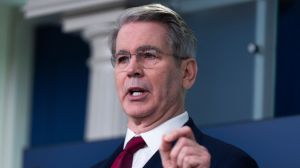Never an easy battlefield
History, they say, repeats itself. As Punjab gets set to elect its 16th assembly, it’s time to look back at its legislature over the years since its reorganisation in 1966. The state has had a rollercoaster ride with quite a few short-lived governments and several spells of President’s rule, one for five years during the dark decade of militancy. Take a read
 During a rally in Bathinda. Photo: Gurmeet Singh
During a rally in Bathinda. Photo: Gurmeet SinghPunjab is proving to be a pollster’s nightmare in this new year. The canny Punjabi voter, so outspoken at most times, is known to spring a surprise at the hustings. And with the state poised for a five-cornered contest, it’s becoming increasingly hard to fathom which way s/he will swing. The traditional parties in the fray have had quite a see-saw relationship with the state’s electorate. While the ruling Congress hit the rock bottom in 1997, winning only 14 seats, its predecessor Shiromani Akali Dal had its comeuppance in 2017 when it could also muster only 14 seats. This, after ruling the state for two successive terms, a record in itself.
Aam Aadmi Party, a newbie in the last assembly election, received a rousing reception in the state, with planeloads of NRIs swooping down to canvass for its little-known candidates, prompting many a pollster to give it a win. But again the voters proved everyone wrong by giving a thumping majority to Congress instead.
In the last year and half, the state, whose farmers spearheaded one of the longest agrarian agitations of independent India, has seen a seismic shift in its political landscape. Shiromani Akali Dal and Bharatiya Janata Party, whose alliance after the dark decade of militancy was considered a guarantor of communal harmony in the state, were torn asunder by the three farm laws in September 2020.
The state saw another breakup late last year when Capt Amarinder Singh, a veteran Congressman and two-time chief minister, quit the party with much angst after his unceremonious ouster from the CMship, to form his own Punjab Lok Congress (PLC).
BJP, which was boycotted by angry farmers for over a year, is coming into its own as a senior partner to the fledgling PLC and breakaway Akali Dal faction led by Sukhdev Singh Dhindsa, riding on the promise of security and a fiscal package from the Centre. In this season of unusual bedfellows, the party also hopes to gain traction from dyed-in-the-wool Congressmen like Fateh Jung Bajwa and Rana Sodhi even though the anger demonstrated by farmers during the PM’s visit doesn’t portend well. But the party leaders are banking on whipping up emotions among a section to garner votes.
Besides PLC, the polls will see another new entrant in Sanyukt Samaj Morcha, a union of 22 farmer unions led by BS Rajewal, that has recently applied for registration. With Haryana BKU chief Gurnam Singh Chaduni saying his party Sanyukt Sangharsh Party is in talks with Rajewal to form a joint front, hope floats for the divided unions. Whether the goodwill they command in the countryside will translate into votes is too early to tell.
The ruling Congress, which came to power with an overwhelming majority in 2017, bagging 77 of the 117 seats, a tally they increased to 80 in the 2019 bypolls, is going to polls with an uneasy partnership of Charanjit Singh Channi, the first Dalit CM of the state who prides himself on his common touch, and the flamboyant PPCC chief Navjot Singh Sidhu. Often the loudest voice against his own party, publicly questioning the doles announced by Channi and making it abundantly clear that he is in the race for the top post with his Punjab model of development, Sidhu could prove to be the proverbial double-edged sword. As of now the party is playing it safe by fighting the elections under “collective leadership”.
AAP, which seemed to be in tatters when its numbers dwindled from 20 to 10 last year, is back in reckoning with party supremo Arvind Kejriwal leading the call for ‘badlav’ with the Delhi model of development and a slew of ‘guarantees’ to every section of the state, including women. Its surprise victory in the Chandigarh MC polls, has boosted its confidence further.
The Akali Dal, which turned 100 last year, was the early bird in these polls. The party, whose patron Parkash Singh Badal has been CM of the state for record five times, was the first to announce its candidates in February last year. These elections are a litmus test for party president Sukhbir Singh Badal who is trying hard to reclaim the Akali cadre and legacy, underlining his connect with the three Ps: Pind (village), panth and Punjabiyat.
All in all, it’s a high-stakes poll not just for the parties but also for the voters who are looking for deliverance.
How Punjab voted in 2017


The long and short of President’s Rule
The state was under President’s Rule eight times for a total of 3,510 days since the country got Independence
June 1951 to April 1952: The assembly was suspended so that the state government could get its act together
July to November 1966: To prepare the state for its reorganisation
August 1968 to FebruAry 1969: Assembly was dissolved after the fall of the coalition government
June 1971 to March 1972: The assembly was dissolved at the recommendation of the incumbent CM due to the poor performance of the party in the March LS polls.
April to June 1977: Giani Zail Singh government was dismissed after the Janata Dal came to power at the Centre
February 1980 to June 1980: In a tit-for-tat, PM Indira Gandhi dissolved non-Cong state governments including that of Parkash Singh Badal on returning to power at the Centre
October 1983 to September 1985: President’s rule was imposed due to internal insurgency
1987 to 1992: Punjab was under President’s rule for
the longest period of five years during the dark decade when the state was gripped by insurgency







